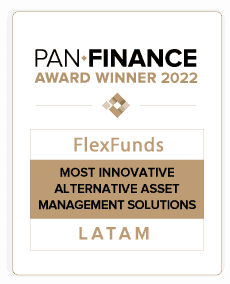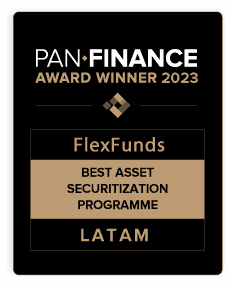- Asset securitization is a popular financial instrument for obtaining financing and is included in asset managers’ portfolios for its ability to diversify and provide exposure to different markets.
- Stocks, bonds, commodities, futures, options, intellectual property, and contracts can be securitized as they generate future flows and can support investors.
- FlexFunds specializes in transforming various asset portfolios into a liquid and flexible investment vehicle through the creation of exchange-traded products (ETPs).
Asset securitization is one of the most popular financial instruments for raising capital. It is often included in the portfolios of asset managers, providing diversification and market exposure for their clients. FlexFunds explains the types of assets that can be securitized.
Through this instrument, an originating entity can convert a group of liquid or illiquid assets into listed securities that can be issued to obtain financing and liquidity for various projects.
With securitization, investors gain returns thanks to the predictable future cash flows generated by productive assets over time, obtaining a type of participation or right to the profits, which are transferred through a professional manager.
“The mechanism of traditional securitization involves transferring a portfolio of assets from a financial entity or company to a vehicle without assets, which then issues bonds guaranteed by that portfolio,” explains the financial entity BBVA1.
FlexFunds transforms asset portfolios into liquid and flexible investment vehicles by creating ETPs (exchange-traded products), facilitating global market distribution, and providing a cost-efficient structure.
Assets suitable for securitization
One of the main qualities of securitization is that it allows converting a variety of assets considered illiquid or with low liquidity into bankable assets.
Among the several assets suitable for securitization are stocks and fixed-income vehicles like bonds held by originating entities, as they provide future flows distributed periodically.
It is also possible to securitize commodities, as well as futures and options. Intangibles like intellectual property can also be securitized based on future royalties.
Another popular option for securitization includes loans and contracts between individuals and/or entities, as these also generate cash flows to support investors using this instrument.
Asset securitization in practice
For example, a real estate company can pool a series of cash-generating assets, including rental income from properties, to repackage them as securities, allowing them to raise funds and continue their development plans.
With asset securitization, this company can diversify its capital access sources and gain greater exposure to global markets, as demonstrated by the American company FlexFunds.
The credit rating agency S&P2 provides another example in the energy sector in Latin America, where companies have used this instrument to raise funds for greenfield projects supported by accounts receivable from their operations.
In fact, it highlights that in the region, so-called repackaged securitization is helping meet financing needs in infrastructure projects, from roads to metro lines.
“Historically, these structures have provided a platform to access investors in international debt markets, necessary for issuances that may be too large for any local market in the region,” says S&P.
Asset securitization adapts to different market cycles, reallocating credit risk and expanding the investor base, which is beneficial in contexts of high interest rates and capital restrictions.
FlexFunds specializes in transforming various asset portfolios into a liquid and flexible investment vehicle through the creation of ETPs called “Flex,” expanding their distribution in global markets.
Flex are structured notes backed by a portfolio of underlying assets. This means that the risk of these securities is directly related to the assets on which they are issued without affecting or being affected by other business operations.
For asset managers and investors, this translates into a cost-efficient structure for developing their investment strategies. Additionally, they offer benefits such as easier incorporation processes and access to their projects.
Asset securitization: why does this instrument benefit from any market trend?
These types of vehicles have the characteristic of adapting to different market cycles, contributing to “reallocating credit risk and expanding the investor base,” according to information from BID Invest3.
By adapting to a diverse basket of assets suitable for securitization, this instrument not only offers exposure to global markets but also adapts to different conditions thanks to the diversification it generates in portfolios.
It also becomes a financing alternative in a context where capital access has become more restricted due to high interest rates persisting due to the inflationary wave that followed the pandemic.
Asset securitization must consider the risk profile, financing requirements, regulation, and economic context, especially in high interest rate environments.
Companies have found in this scheme a channel to diversify their funding sources while contributing to the capital market development in various projects and sectors of the economy.
However, like any other financial alternative, the risk profile and funding requirement of each organization must be considered based on their corporate objectives, taking into account factors such as regulation and the economic situation marked by restrictive monetary policy.
In this context, FlexFunds facilitates asset securitization and, through its ETPs, converts clients’ asset portfolios into “bankable assets” efficiently and quickly (in 6 to 8 weeks), catering to asset managers of all sizes, facilitating the distribution of investment strategies.
Commercialization is simplified and reduced to a transaction to purchase the issued security, and distribution is done through a placement agent. FlexFunds creates Euroclearable ETPs, providing access to international private banking platforms. Thanks to agreements with prestigious global providers, it offers a simplified, high-quality, and competitively priced securitization process. For more information, do not hesitate to contact our experts.
Sources:
- 1https://www.bbva.com/en/promote-credit-securitization/
- 2https://www.spglobal.com/ratings/en/research/articles/240415-latin-america-cross-border-securitization-market-primer-13072090
- 3https://idbinvest.org/en/blog/development-impact/securitization-tool-issuers-reallocate-credit-risk-and-widen-investor-base







